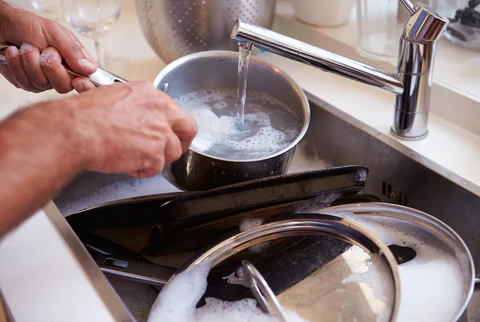Holiday Dishwashing Guide
No one likes being on dish duty, especially after a holiday feast! To help make washing those dishes a little easier, we’ve put together a guide with a few tips and tricks to cleaning everything from plates and burnt pans, to nonstick pots and cast iron skillets!
Soaking Station
Soak pots and pans as soon as you transfer your food to serving platters. However, instead of filling the sink with pots and pans, designate a small trashcan or a few dish tubs as the soaking area. Not only will soaking your pots in a tub of soapy water help bust through the leftover food and grime from cooking, but it will free up sink space so you can easily wash your other smaller dishes.

Plates, Cups and Silverware
As you clear your dinner table, be sure not to stack dirty plates. This just dirties the underside of your plates with more food, thus adding to the amount you need to clean. When you go to clean your plates, scrape excess food into the trash and rinse with water. If the plate is more soiled, scrub lightly with a sponge to remove additional debris. After rinsing, immediately place the plate in the dishwasher. We recommend placing all plates, bowls, cups and silverware in the dishwasher and saving your larger serving platters and miscellaneous pots and pans for handwashing. Set your dishwasher to the strongest setting, and use a strong dish detergent like Boulder Clean’s Dishwasher Detergent Gel or Dishwasher Detergent Power Packs.
Burnt Pots, Pans and Casserole Dishes
After soaking, washing, rinsing and drying, coat the tough spots in baking soda. Then, in a small bowl, combine 1 cup of hot water and 1/3 cup vinegar. Pour this mixture onto your burnt spots. Let the cookware soak for an hour, then start scrubbing again. Repeat until the burnt pieces are all gone.
Nonstick
To clean your nonstick pots and pans, simply wash with hot, soapy water using a soft sponge. Avoid using abrasive sponges, steel wool, or brillo cleaning pads. Every time you use tough abrasive sponges, you risk scraping off the nonstick finish. Unfortunately, this also means that nonstick cookware must be washed by hand, unless it explicitly says it is dishwasher safe. The dishwashing process will scrape of the nonstick finish just as an abrasive sponge will.

Stainless Steel
To clean your stainless steel, start by washing with hot, soapy water. Allow it to soak, if there are burnt bits of food stuck to the surface. After several uses, you’ll probably notice the surface of your stainless steel pots and pans, has started to turn brown. To remove these brown stains from your stainless steel cookware, try washing a few times with hot, soapy water. If soap and water doesn’t help, you might need to enlist the help of a more serious cleaning agent. Check your local store for a gentle dish cleanser, grab a couple sponges (if you’re worried about scratches look for a non-scratching dish pad), and start scrubbing! After you’ve worked the cleanser into you cookware, rinse and wash again with dish soap and hot water.
Cast Iron
Lodge Cast Iron recommends the following process for cleaning your cast iron skillet; Wash your cast iron cookware by hand using a small amount of dish soap. If needed, use a pan scraper for stuck on food. For stubborn, stuck-on food, simmer a little water for 3-5 minutes, then use the scraper after the pan has cooled. Dry promptly and thoroughly with a lint-free cloth or paper towel. Or you can place your skillet on the stove for 1-3 minutes and allow the heat to fully dry it. Rub a very light layer of cooking oil onto the surface of your cookware. Use a paper towel to wipe the surface until no oil residue remains.
Copper
You can wash your copper cookware with soap and hot water. If there are bits of food stuck to your cookware, you can let it soak in soapy water for a few minutes to help loosen the food. To keep your copper cookware from tarnishing, make sure you polish it often. To polish your copper cookware, you can purchase copper polish or for a DIY polish, try rubbing the exterior of the cookware with lemon halves that have been dipped in salt. Lemon has acids that can work together to help remove the tarnish.
